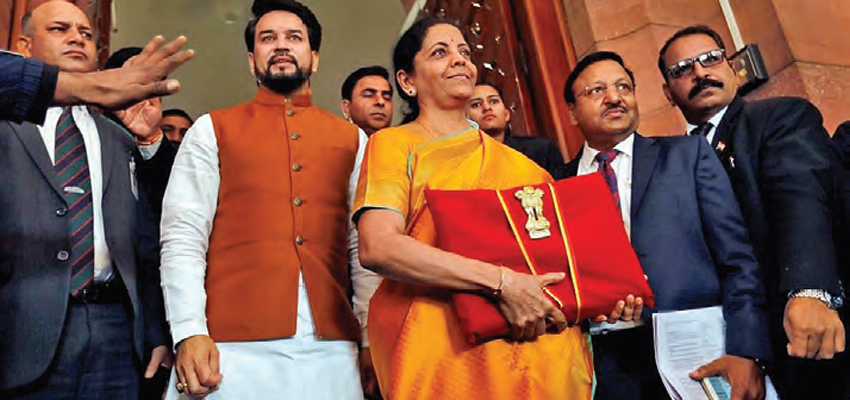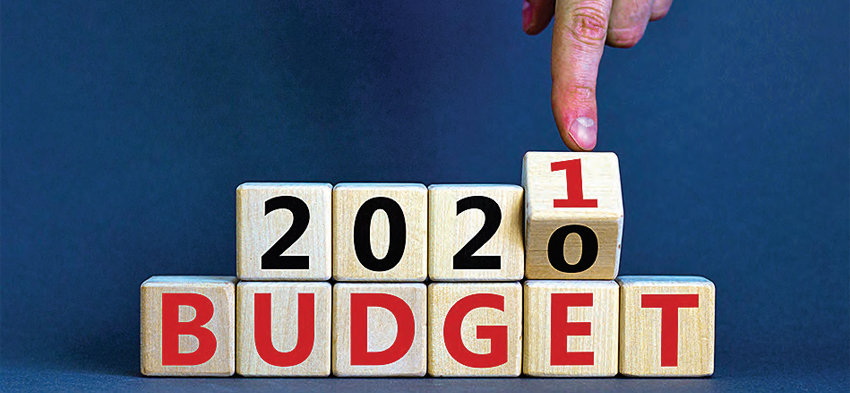More growth-oriented than tax-focused

In the midst of the gloomy days induced by the corona pandemic, the Finance Minister has brought in a Budget that is aimed at giving a gentle push to the economy. Contrary to most doomsday predictions, it has turned out to be more growth-oriented than tax-focused, with more thrust to infrastructure build-out, healthcare, human capital and innovation
The Budget 2021 has been presented amidst the economic gloom caused by the pandemic. The global economy suffered last year and many countries are still suffering. India was no exception, and we witnessed a sharp contraction in our growth. Our first quarter growth figure for the FY 2020-21 was -23.9% while the second quarter figure was -7.5% of the GDP. At the onset of the pandemic, our Prime Minister said that our priority has to be to save lives, and this resulted in lockdowns impacting our economy seriously. The government went on spending by providing help to the poor, providing payouts for medical care and then later by giving stimulus to reopen the economy. The pandemic created payouts bulldozed fiscal discipline and the budgeted fiscal-deficit of 3.5% as per the Budget 2020 became a statistic of no consequence.
PLEASANT SURPRISE
Economists feared that over such a dismal background, Budget 2021 would be really harsh. They presumed that direct tax would be upwardly revised or there might be a mounting of a steep corona-cess. They also anticipated that there might be a revival of wealth tax, as there was a wealth increase of the super-rich, due to a lull in the capital market in the latter part of last year, and in January 2021. But there was a big surprise in store, as nothing happened as feared when Budget 2021 was presented. On the contrary, this Budget made everybody euphoric. The capital market went up to dizzy heights, the Sensex continuing its climbs for successive days after the Budget presentation. Economists kept on praising the Budget. This column attempts to outline the main features of this year’s Budget in plain words.
NO DIRECT TAX CHANGES
The Budget is more growth-oriented than tax focused. The Budget does not change the basic tax rates under the direct tax and gives emphasis to the future. In the aftermath of the contracted economy of FY 2020-21, the Finance Minister decided to catch the bull by the horns and has tried to transform the challenge into an opportunity. The main pillars of Budget 2021 are: physical infrastructure, health, human capital, innovation and R&D.
"In FY 20-21, the government went on spending by providing help to the poor, providing payouts for medical care and then later by giving stimulus to reopen the economy"
BOOST TO INFRASTRUCTURE
The government decided to have more quality spending, which may bring a trigger-effect to put the economy on a rising trajectory. For example, capital spending on infrastructure is budgeted at over Rs.5.5 lakh crores for the year, which is nearly 35% increase over the last budgeted figure and which works out to 2.5% of the GDP. The national infrastructure pipeline is being expanded to cover 7400 projects. There is an ambitious aim to complete 11,000 km of national highway infrastructure this year.
To boost the manufacturing sector, the production linked incentive (PLI), with an outlay of Rs.1.07 lakh crores for five years has been announced. There has been an outlay of Rs.1.10 lakh crore for railways, of which, a major part is for capital expenditure. The power sector is to get an outlay of Rs.3.05 lakh crores with an added benefit to consumers that they will be provided with alternatives to choose power distribution companies. There is a big boost to the health and well being sector with an outlay of Rs.2,29,846 which is 138% higher than the last year, and which also includes Rs.35,000 crores for covid vaccines. The Jal Jeevan Mission, which will ensure universal water supply will receive Rs.50,000 crores, a marked increase of 355% from last year.
MORE TRANSPARENT
Budget-2021 ensures transparency. It was common knowledge that during budget making some expenses used to be put under a veil so as to present a better picture of the fiscal-deficit. The presentation of a better financial picture used to be a necessary call, so as to get good ratings from rating agencies. This year no such efforts have been made and the government believes that even the rating agencies will be more understanding because of the adverse corona impact. The Budget this year has shown an expenditure of Rs.34.5 lakh crores and the fiscal-deficit of 9.5% of GDP for the current year. The unusually high fiscal-deficit speaks of transparency in revealing the expenses. For example, FCI used to book loans in its accounts and the real food subsidy outgoing used to be kept hidden. This year, the food subsidy has been shown as over Rs.4 lakh crore as against the budgeted figure of less than Rs.2 lakh crore. For FY 2021-22, the budgeted expenditure is Rs.34.8 lakh crores and the anticipated fiscal-deficit is 6.8%.
Tax revenue has been shown at a realistic figure, being only 16% higher than last year. It is believed that the actual tax revenue will be more than the budgeted estimate. The high fiscal-deficit announced is not possible unless the FRBM Act is amended, which mandates a fiscal-deficit of 3% of the GDP, and accordingly the Budget. It is necessary to amend this Act within this session. The Finance Minister has said that the fiscal-deficit will gradually be reduced to reach levels of 4% by the year 2025-26. The high fiscal-deficit today was the need of the hour with a priority to spend more.
PRIVATISATION PLANS
So also, for the first time, the Budget speaks of ‘privatisation’. The Budget proposes to privatise two public sector banks during the FY 2021-22 along with one general insurance company. The FDI limit of 49% in the insurance sector has been increased to 74%. The Finance Minister also spoke that gradually, all public sector companies will get privatised, except for those in the strategic four core sectors, and even in those sectors, the number of companies will be reduced. The disinvestment target for FY 2021-22 has been set at Rs.1.75 lakh crores. Economists have appreciated the idea of privatisation, as it is not the job of the government to do business, as the real job of the government is to do governance. Air India will continue to be under the disinvestment hammer in the coming financial year. Precious taxpayer money should not be wasted on perpetually loss making public sector companies anyway. Even the really rich LIC will come with an IPO in the coming financial year, and the same is a big news for investors.
"The Budget relaxes the compliance burden for senior citizens (above 75 years of age) earning pension and interest income. Now they will not be required to file income tax returns"

TAX LAW TWEAKS
Though tax rates have not been tinkered with, there are some tax proposals under the direct tax. Most of them are for the benefit of taxpayers. Some important ones are as under:
1. Relaxes compliance burden for senior citizens (above 75 years of age) earning pension and interest income. Now they will not be required to file income tax returns.
2. Reopening time limit for tax assessments has been reduced to three years from six years for the benefit of taxpayers. In a very limited number of cases of serious tax evasion of more than Rs.50 lakhs, the time limit for the reopening of assessment will be 10 years, and this too will happen only with the approval of the Principal Commissioner.
3. The Income Tax Appellate Tribunal (ITAT) will also go faceless in the continuance of faceless assessments and appeals before the commissioner. This will reduce the cost of litigation and also give transparency even at the higher level of appeals.
4. To help small taxpayers, a dispute resolution mechanism has been proposed. This will apply to those cases where the income of tax payers is less than Rs.50 lakhs, and the disputed income is Rs.10 lakhs or less. This will help reduce litigation.
5. Tax audit limit has been increased from the current Rs.5 crores to Rs.10 crores in cases where cash recipients and payments do not exceed 5% of total recipients/payments.
6. Dividend payment to REITS and INVTS will be exempt from TDS.
7. NRIs to benefit, as TDS on dividend income will be at a lower treaty rate.
8. Additional interest deduction of Rs.1.5 lakh on affordable house purchase will continue for one more year.
9. Affordable housing projects can avail another year of a tax holiday.
10. The Budget proposes tax holiday for aircraft leasing companies. Also, tax exemptions on lease rental paid by airlines to foreign lessors.
11. Income tax returns will have more pre-filled information on dividend, interest and capital gains to ease the compliance burden.
12. Capital gains exemption for investment in startups to be extended by another year.
13. Deep analytics and artificial intelligence to be used to catch fake billers.
14. Big change in search assessment cases under Sections 153A and 153C of the Act introduced for the re-opening of assessments, and this will be helpful to the taxpayers.
15. New provision under section 148A of the Act introduced for the re-opening of assessments, which will be helpful to taxpayers.
16. ULIPs premium above Rs.2.50 lakh PA now taxable. However, this cap will be applicable in respect of policies taken on or after 1st April 2021.
17. NRI rules relaxed, as the number of days of stay in India reduced from 182 days to 120 days.
Under customs laws, there is some tweaking of provisions and a significant number of reviews of exemptions. The Budget has kept in mind ‘Atmanirbhar Bharat’ while doing so. Imports, which hurt our own indigenous production have been underlined. A good distinction has been kept while reviewing customs duties between import substitution and things needed for self-reliance. Our industrial sector has welcomed it.